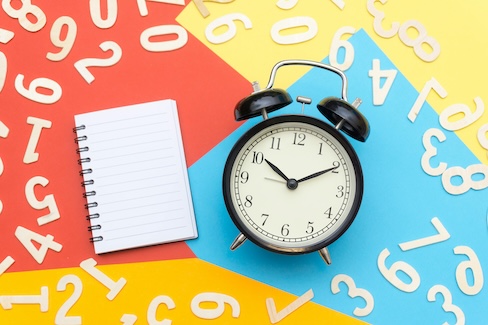
It happened again. We turned the clocks back an hour for Daylight Savings Time. < insert very loud groan and whine >
Why do we continue to do this to ourselves? Don’t get me wrong. I love that I get an extra hour of sleep in theory.
But I don’t love how all week long I end up thinking …”okay, it says 5pm but it’s really 6pm,” and how it’s dark so early. Everything feels off balance. I’m off balance. And even with that theoretical extra hour, I’m exhausted.
And even if you’re still getting your regular number of hours, this week you may feel oddly hungover…exhausted…unfocused…foggy… majorly jetlagged without traveling a mile from home. As if someone turned your ADHD dial up to 1100.
You’ve heard me say over and over and over again – sleep is VITAL for proper brain productivity, mental health and well-being. VITAL. So let’s fix this ASAP!
Here are a few things you can do to adjust to the time change so you can ensure a good night’s sleep:
- Respect your need for sleep. Just like you now drink water and exercise, put sleep at the top of your self-care regimen. THE VERY TOP. Move that TV show or Tik Tok or even date night to the bottom. (Okay, keep date night, just cut it a bit short.)
- Ignore the time and listen to your body. As best you can. There is no normal bedtime right now. So when you’ve hit the wall, start your bedtime routine. No matter what the clock says. Ease slowly into the time change.
- Create a bedtime routine (and set a reminder to do it). Quiet, small routines signal your brain that it is time to relax and settle down for the night. Routines are important, yet unnatural for people with Attention Deficit. Some ideas for routines: let the dog out, take a warm shower, put on your PJs, turn off lights, check that the doors are locked.
- Avoid mental stimulation before bed. Once your brain gets stimulated, it’s hard to shut it down. Make sure you turn off the computer and put away your phone at least an hour before bedtime. Maybe even two this week until things settle. That means no email, social media, or video games. Hard, I know, but all those flashing lights and information mess with sleep.
- Bore your brain to sleep. Once you’re in bed, you need to take conscious steps to relax your brain so it will settle into sleep. Read a book, meditate, listen to music or a podcast, watch calming TV. Tell your brain it’s time for sleep.
I know these steps are easier said than done. I understand you’re busy and you have so many things to do that this may feel overwhelming. You want to get back on track NOW.
But sleep is one of the great natural remedies for ADHD and not getting enough makes your ADHD symptoms worse and everything so much harder. And it’s sooooo easy for us to get into a bad habit and those cute fluffy sheep we count each night can easily turn evil and vicious when sleep feels like an impossible dream. So take the time now to adjust and get into a better bedtime routine.
You’ll thank me for it! (And if not, we can all move to Arizona before we turn the clocks ahead in Spring!)
Looking for other ways to manage your ADHD? Check out:

 Tired of struggling with ADHD? You’re in the right place. ADHD Success is loaded with free, practical tips to help you get organized, manage your time, and live more easily with Adult ADHD. Like what you read? Sign up for the newsletter now! No Spam. I promise!
Tired of struggling with ADHD? You’re in the right place. ADHD Success is loaded with free, practical tips to help you get organized, manage your time, and live more easily with Adult ADHD. Like what you read? Sign up for the newsletter now! No Spam. I promise!
0 Comments